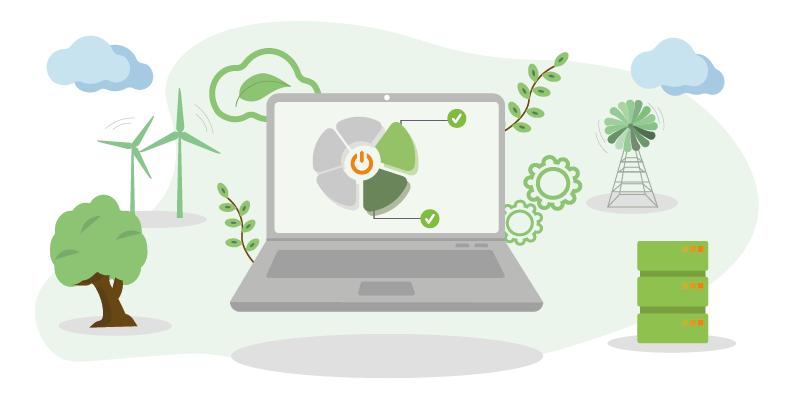Every industry, including IT, is under pressure to look for ways to reduce its carbon footprint to reduce the threat of climate change through more sustainable practices. Green IT as a concept has been around for quite some time, it is the practice of using information technology in an environmentally sustainable way, with a focus on reducing carbon emissions and energy consumption. Yet, for such an innovative sector - the overall adoption has been slow.
Our reliance on AI technologies and software to drive better business operations is consuming power at an alarming rate. Currently, the technology and telecom sector generates an estimated 5% of global CO2 emissions, however, as Forbes stated here, this number is expected to surge to as much as 14% by 2040.
The importance of Green IT
Green IT can make a significant difference to the carbon emissions that we produce. By adopting sustainable IT practices and using energy-efficient hardware and renewable energy sources, businesses can reduce their environmental impact while also saving money on energy costs. But time is not on our side:
- In 2021, 57.4 Mt (Million Metric Tonnes) of e-waste was generated with the total growing by an average of 2 Mt a year. Source - The Roundup.org
- The data centre industry accounts for around 4% of global electricity consumption and 1% of global greenhouse gas emissions. Source - Engie
- Emissions from cloud computing range from 5% to 3.7% of all global greenhouse gas emissions, thereby exceeding emissions from commercial flights (about 2.4%) Source - The ShiftProject
- The internet accounts for 10% of global electricity demand and, as more people around the world gain access, that percentage is set to rise to as much as 20% by 2030. Source - OVO energy
- The development of e-commerce over the next 5-10 years could lead to a massive increase in carbon emissions, counteracting the net-zero trajectory due to a flawed model based on the shift from offline to online. Source - WEForum
- Telecommuting may seem like a greener alternative until you factor in new office equipment, personal heating, WiFi, electricity etc. There is still a lot of educating to do, to keep overall carbon emissions lower than working in a shared office.
What are the benefits of Green IT?
Increasing environmental sustainability is obviously a big advantage of Green IT, but there are also cost savings, competitive advantage and regulatory compliance benefits for businesses to gain through implementing Green IT strategies.
Cost savings
One of the primary benefits of green IT for businesses is cost savings. By adopting energy-efficient hardware and using virtualization technology, businesses can reduce their energy consumption and save money on electricity bills. VMware says that virtualization can reduce the number of physical servers required and can reduce energy consumption by up to 80%. In addition, by reducing paper use and implementing digital document management systems, businesses can save money on printing and paper costs. Overall, green IT can help businesses reduce their operating costs and increase their bottom line.
Competitive advantage
Businesses that adopt green IT practices can also gain a competitive advantage in the marketplace. Consumers are becoming increasingly environmentally conscious and are more likely to do business with companies that prioritize sustainability. According to The Economist Intelligence Unit, over the past five years, there has been a 71% rise in online searches for sustainable goods globally. By promoting your organization's green initiatives and implementing sustainable IT practices, you can attract environmentally conscious customers and gain a competitive edge in your industry.
Regulatory compliance
Finally, businesses that adopt green IT practices can ensure regulatory compliance with environmental regulations. Many governments around the world are implementing regulations to reduce carbon emissions and promote environmental sustainability. For example, in 2022 more than 30 UK companies were fined by the Environment Agency as part of an effort to reduce greenhouse gas emissions. By adopting green IT practices, businesses can comply with these regulations and avoid fines and penalties for non-compliance.
The benefits make sense and the importance is clear, so how can you get started with your Green IT strategy?
Find out more about Green IT in our webinar:
Best practices for implementing Green IT in your organization
Use energy-efficient hardware: Choose hardware with green certifications such as ENERGY STAR, BREEAM or EPEAT or those that use low-power components to reduce energy consumption.
Virtualize your IT infrastructure: Virtualization technology enables businesses to consolidate multiple servers as virtual machines (VMs) and reduce the number of physical servers required, ultimately reducing energy consumption.
Select sustainable software: Choose service providers that prioritize environmental sustainability. Keep abreast of some of the latest initiatives that encourage more efficient and carbon-reducing solutions e.g. the Software Carbon Intensity (SCI) Specification.
Use renewable energy sources: Consider using renewable energy sources, such as solar or wind power, to power your IT infrastructure.
Reduce paper use: Implement digital document management systems and encourage employees to use electronic communication instead of paper-based communication.
Recycle e-waste: Implement e-waste recycling programs to reduce the environmental impact of discarded IT equipment. If there really is no more use for the product, the batteries and electronic components can still be recycled.
Transparency is key for Green IT
To achieve your Green IT initiatives, you must engage the whole organization and gather details from each area of the business to ensure that data is accurate and you have full transparency. At Serviceware we provide a CO2 analysis for businesses to make this process simple, digitalized and precise.
So is it too late for Green IT? Absolutely not, but to make a substantial impact on CO2 emissions, we all need to do our bit. Technology services and providers must put sustainability at the top of the agenda in the boardroom and do everything they can to implement more sustainable solutions for users, as well as educate the market. Users must shop smart, selecting only IT solutions that align with their environmental goals and meet Green IT certifications.
Together, by adopting sustainable IT practices, we can all make a positive difference.

 German
German

